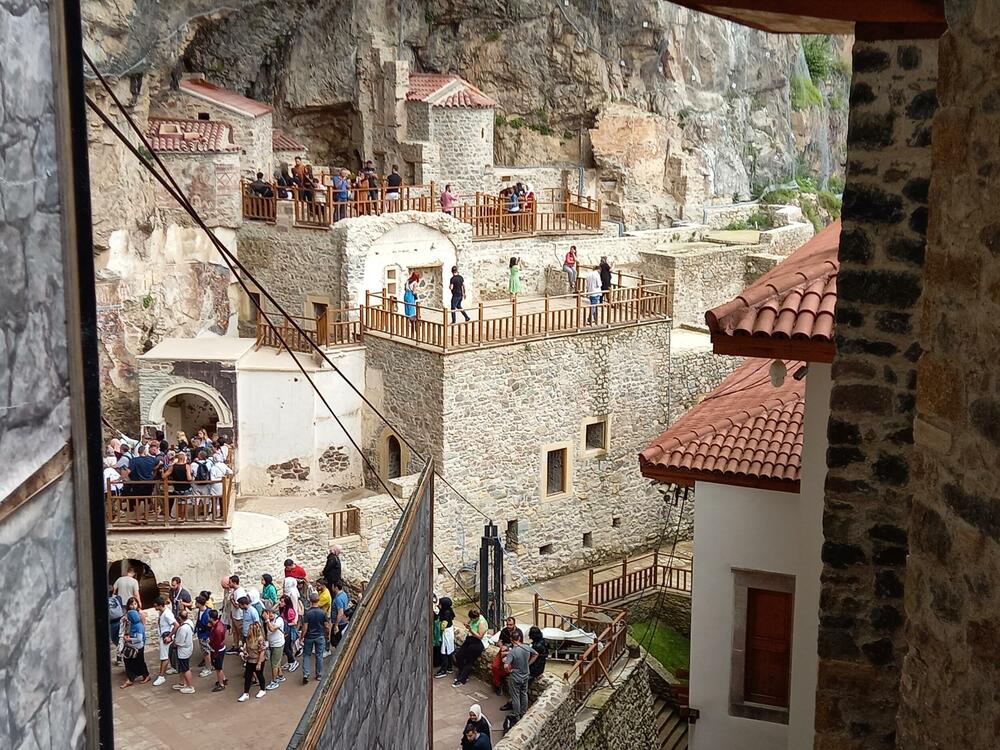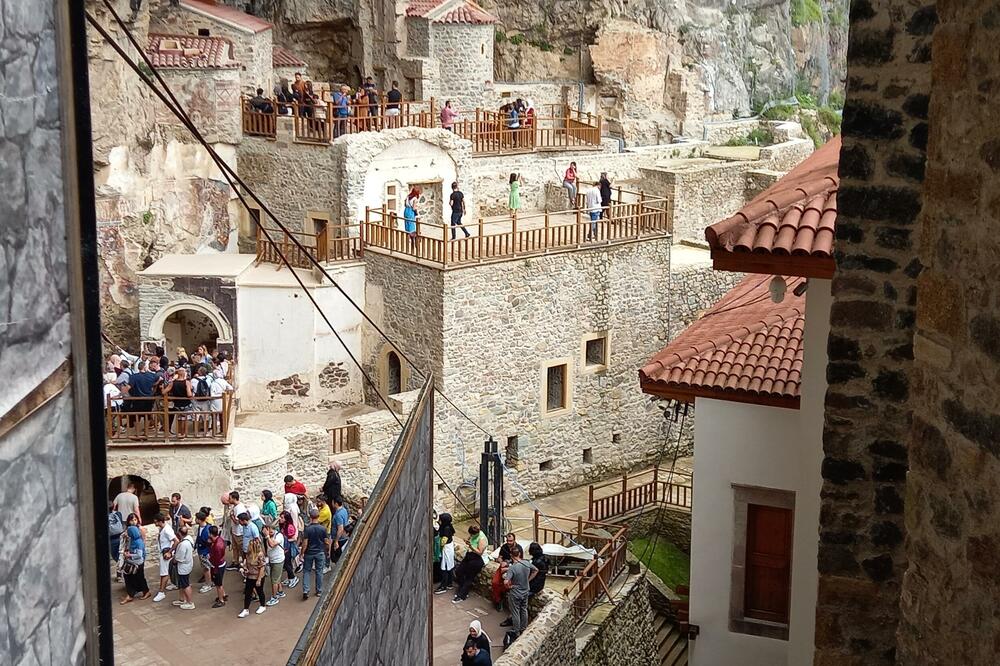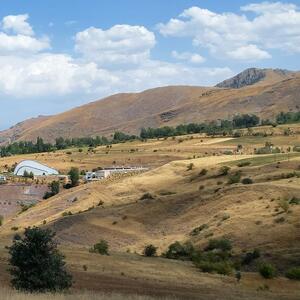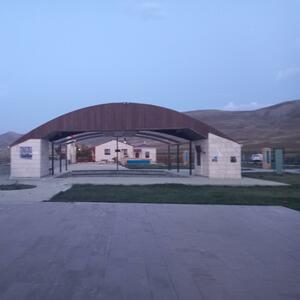Built into the rocks of the "black mountain" not far from the Black Sea, the Sumela Monastery within the Altindere National Park, which was founded in 1987 in the district of Macka, province of the city of Trabzon in Turkey, evokes admiration, (awe) and delight.
Almost above the precipice, on a cliff, among the clouds, is located like an ancient city, the (once) Orthodox monastery of the Patriarchate of Constantinople, a tourist, as well as a religious and archaeological attraction.
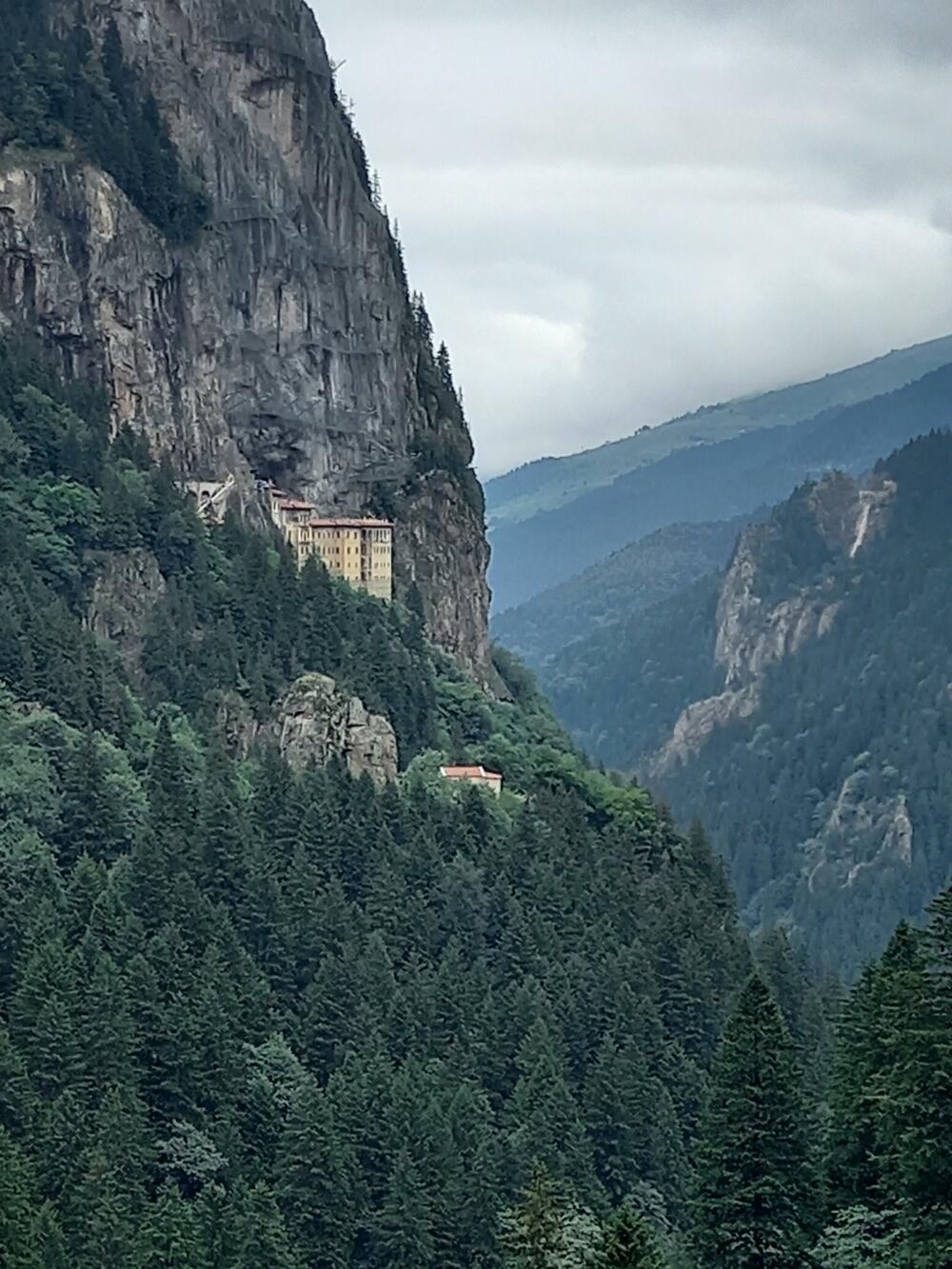
With a view of the rich history and stormy past, layered culture, powerful and unsurpassed architecture, and untouched nature, the endless greenery of Trabzon's forests, at 1.200 meters above sea level, the Sumela monastery was carved and built at the end of the fourth century and has withstood the test of time and (un)time. , weather and adversity, wars, turmoil, vandals and so on despite everything, centuries later until today and centuries from now.
I had the opportunity to visit this monumental building, to walk through the Altindere National Park on narrow roads and climb almost improvised wooden stairs made with attention to nature, and then to step on the concrete, high and extremely narrow stairs, after which the door opens for me "Sumela of the city". While I am writing this, I am recalling my visit to Sumela and it seems to me as if I am in the set of a movie with an ancient theme, but the images are real, alive, loud, and even now it is as if I am turning around on my axis while looking at the frescoes in the church created from the cave or admiring overlooking the lush nature of Altindere National Park, which preserves this building far from the city.
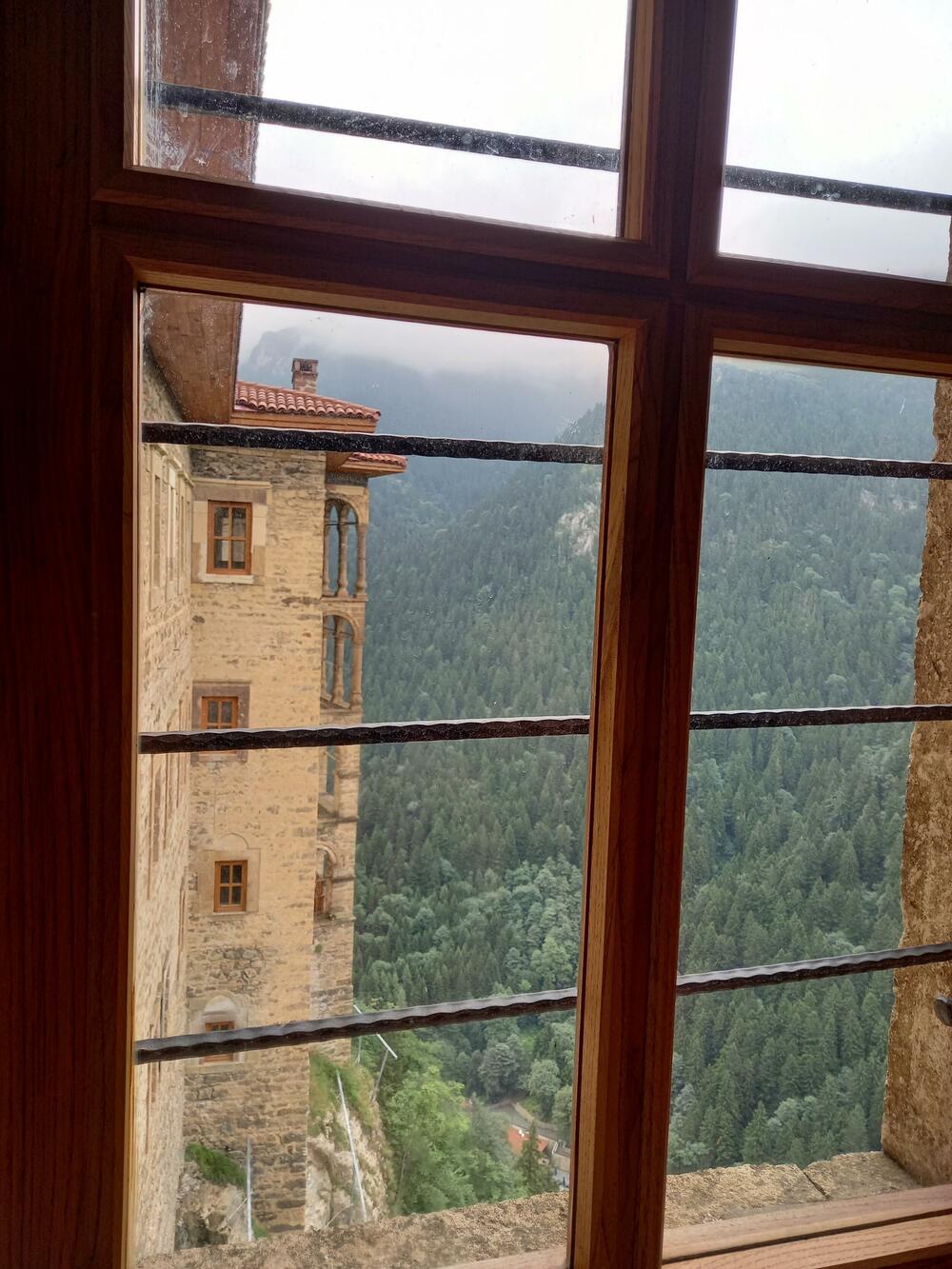
I visited the Sumela monastery thanks to the Ministry of Culture and Tourism of the Republic of Turkey, which is trying to promote and present all parts of the country to tourists. With the desire to spread the word about the unusual beauty and attractions of the Black Sea region, a visit was organized for journalists from Serbia, Bosnia and Herzegovina, Romania, Bulgaria, Poland and Montenegro (through the Turkish Cultural Center Yunus Emre Podgorica) during which we got to know a part of the region of Turkey. located on the coast of the Black Sea. And although other destinations in Turkey are generally more attractive to many tourists, the experience that the Black Sea region and the Trabzon - Gumuşane - Bajburt triangle provides is one that you will later describe as unforgettable...
That morning we left Trabzon for the black mountains whose contours we could make out in the distance (and height), and the friendly tour guide Juksel Malkoc during the short drive, he told us some of the interesting things related to the Sumela monastery.
Guided by a dream and the call of the Mother of God, they laid the foundations
The impressive building dates from the end of the fourth century, around 365-395 and the reign of the Byzantine emperor Theodosius I. The name of the monastery, explains Malkoč, comes from the words "sou" and "mela(s)", which in Greek means "on the Mela mountain", that is, "on the Black mountain" because "melas" means black. The name of the mountain is also derived from the same adjectives with the same meaning - "black mountain", which also reminds me of Montenegro.
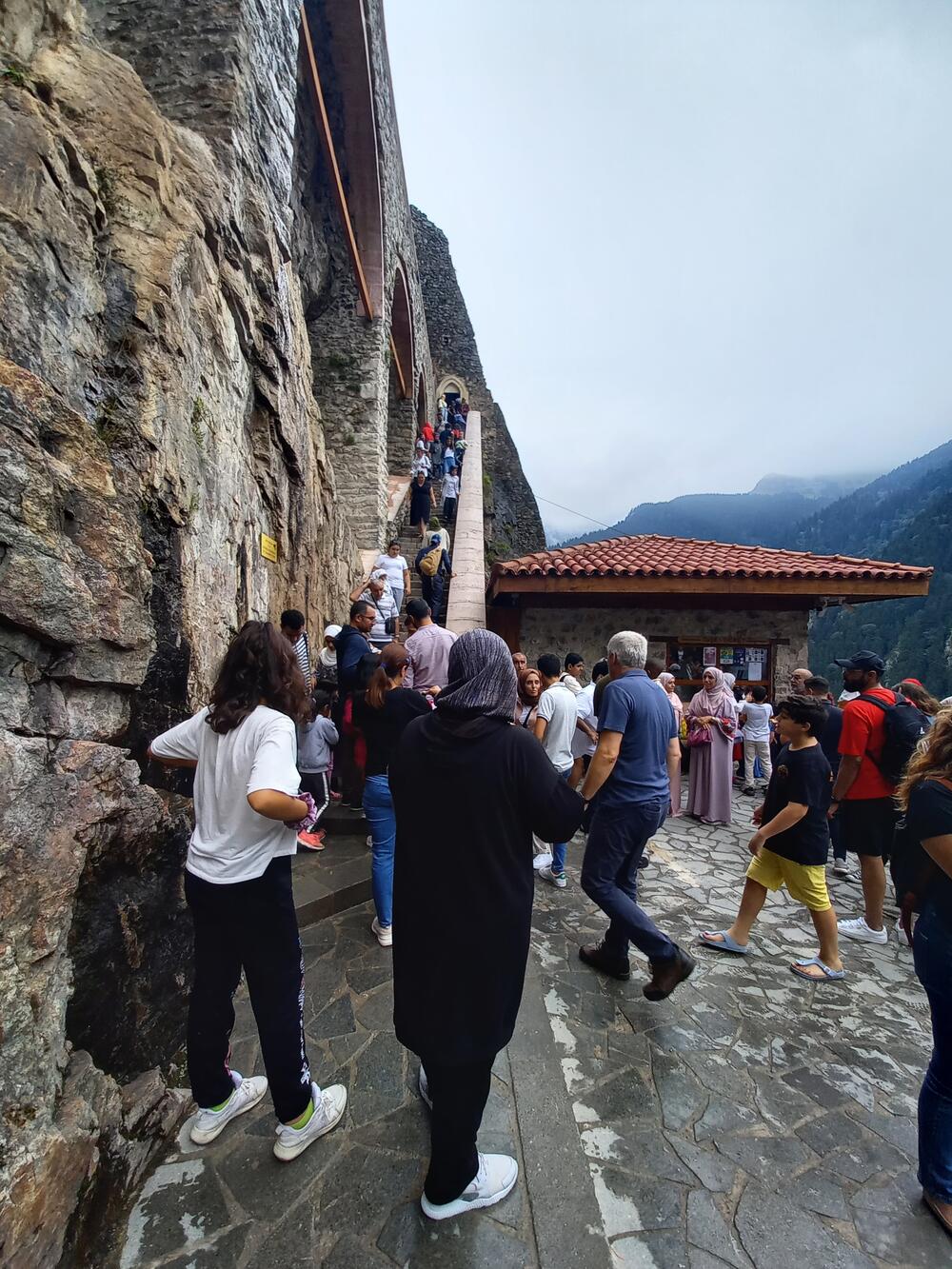
It is interesting that Sumela is located about 46 kilometers from the Black Sea and is one of the biggest attractions in this area, but also in the world when it comes to religious tourism. And that reminds me of Montenegro and my thoughts go to the Ostrog monastery...
However, in addition to the mountain, the word "melas" can also refer to the icon of the Virgin Mary, which bears the name of the monastery and which was located in the monastery for centuries, and is so dark that people described it as black. The monastery of Sumela is popularly known as the monastery of the Blessed Virgin because it is dedicated to her, i.e. it was built in honor of the Virgin, and there are several different versions that tell about its origin. The story of the Mother of God and the icon of the Most Holy Mother of God Panagia Sumela the Miraculous are the basis of all versions.
It is believed that since the end of the fourth century, the Sumela monastery has kept the aforementioned icon, which, according to tradition, was painted by the apostle Luke himself. According to some sources, she was first located in Athens, where she was called the Mother of God Atiniotis, but was later transferred to Pontus, to be safer. According to legend, it was the relocation of the icon that led to the creation of the Sumela monastery.
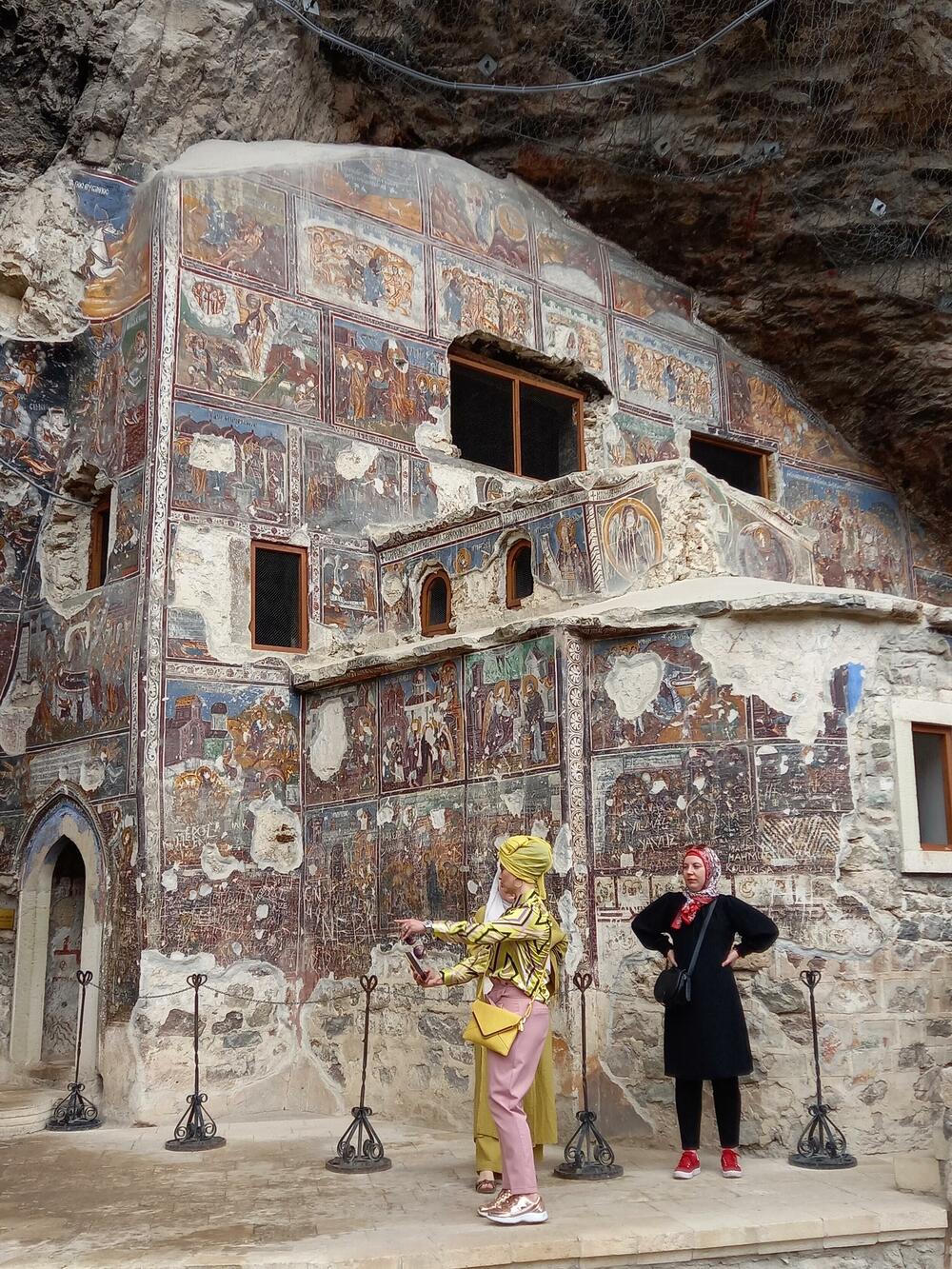
The first version is that the icon was brought from Athens to Trabzon by two monks, Saint Barnabas and Saint Sophronius, and founded a monastery there. The second, more common legend itself has several versions, but it is based on the fact that the monastery was built by the Athenian monk Barnabas after he dreamed of the Virgin Mary, who told him in a dream that he should go on a journey to the Black Mountains, in Asia Minor, and that there ( in a cave) to find her icon painted by Saint Luke. She should build a monastery on that place, she told him in her dream. When he woke up, Barnabas did not think, but started, and his nephew Sophronius, or the monk Sophronius, it depends on the interpretation, joined him on the journey. And everything was as Barnabas had dreamed.
There is also a similar version that two monks, one in Athens, the other in Istanbul, dreamed of the Mother of God, the virgin Mary, at or around the same time. In a dream, they saw the icon flying and falling into the mountains of Trabzon, while another version of the transfer of the icon is that they saw angels carrying it through the clouds and placing it in a cave... The Virgin Mary with baby Jesus in her arms addressed the monks in a dream and said to them to build her a home in that place. The two monks, not knowing about each other, set out on their way to the present-day Altindere National Park and came to the Black Mountain that Blessed Mary had described to them in a dream. On their way, they bumped into each other and shared their dreams, deciding to continue their mission together. They stayed in the mountain for days and nights until one day they came across a cave with an icon, and then they built a church in that place with their joint efforts, where they lived for the rest of their lives. It is believed that the monastery was built there only after their death.
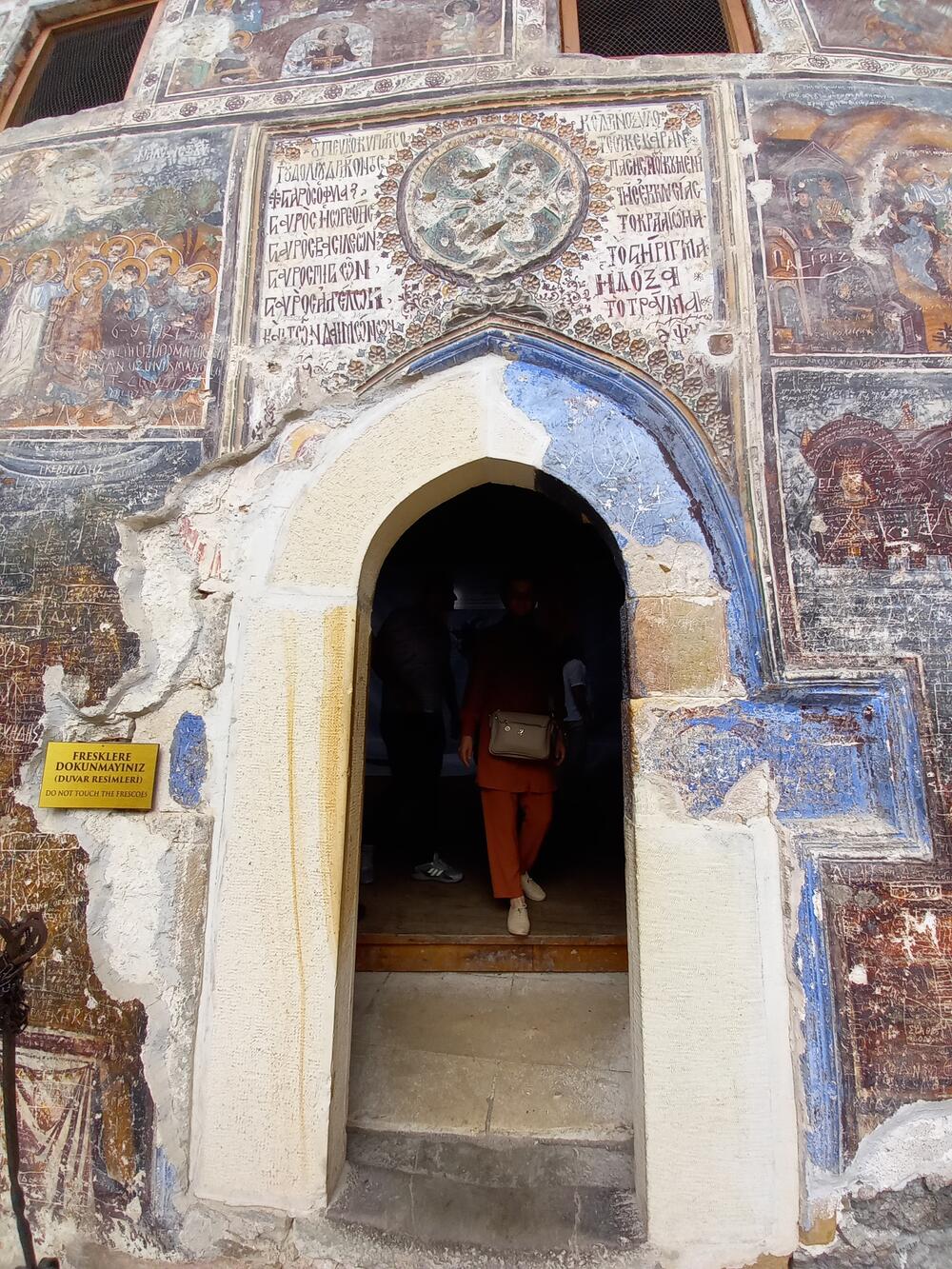
According to a legend recounted among the Greeks of the Black Sea, two Athenian monks, Barnabas and Sophronius, also had the same dream in which they saw the black mountains which the Virgin told them was the place where the icon of Mary holding the child in her arms is located. Jesus, which is one of the three icons made by the apostle Luke. According to that legend, also unaware of each other, they sailed by sea to Trabzon, met and told each other their dreams and continued their journey together, and when they reached the place they dreamed of, they already found the foundations there and continued building the first church.
In any case, it is believed that the church was built between 365 and 395. What can be concluded from the style of the building is that it was built in the style of Cappadocia churches, which are common in Anatolia... And yet, it seems anything but usual.
Not much is known about the period between the first establishment of the church and its transformation into a monastery. According to some data, some parts were built during the emperor's time Anastasija (430-518). Construction continued during the reign of the emperor of Justinian (527-565), and scientists claim that the real, large-scale construction of the walls began in the 13th century. In addition, some sources say that he is the real founder of the monastery Alexius 1349-1390.
It is also interesting that he conquered the province of Trabzon, the oldest trading port of Anatolia Sultan Mehmed the Conqueror in 1461. In order to continue the traditional respect for all religions in the Ottoman Empire and in the desire to enable the peaceful practice of religion for everyone, the Sultan issued an edict protecting all religious buildings, including the Sumela Monastery. The Sumela monastery was mostly built in the era of the Ottoman Empire. Javuz Sultan Selim while he was the governor of Trabzon contributed to the more modern appearance of the monastery when a special room was made for the library to which he donated many books and valuable golden candelabra.
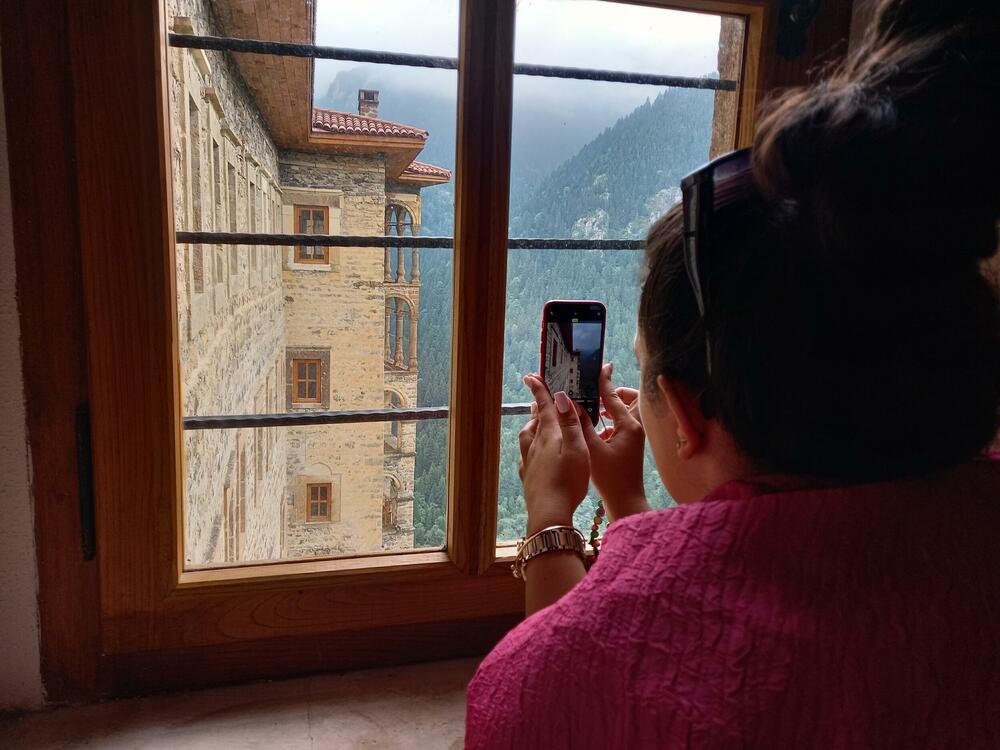
Considering the time from which it dates and the different circumstances it was exposed to, the monastery complex was reconstructed several times, perhaps the most in the sixth century, while the current form dates from the 13th century. In the 18th and 19th centuries, many frescoes and auxiliary buildings were added.
The monastery was also the educational center of that climate for a long time. However, during the First World War, the monastery was attacked, and the icon of the Virgin Mary was hidden in the rocks of the mountain on which the monastery itself is located. Later the icon was found and transferred to another place. There is information that the icon of the Virgin of Sumela is today in a monastery in Aegean Macedonia, which bears the name of the icon, where it was taken by the Greeks from Pontus in 1923, after the exchange of population between Greece and Turkey, the icon was taken with them by the Pontic Greeks.
The Sumela Monastery is on the UNESCO World Heritage List and is an extremely rare, unique and powerful architectural complex. It is a very attractive and popular destination due to its cultural-historical and religious significance, so believers from all over the world visit it, some for the unobstructed view of forest areas and greenery, some for religious significance and beliefs.
Air, water, forest, stone...
And the way to the monastery, no director or scenographer could have imagined and created more efficiently... We started from Trabzon and it seems to me that already entering the territory of the Cat, you feel something special, different. However, the journey from the foothills to the monastery itself is a magnificent experience, like some unknown process by which you will fulfill your own goals, but not knowing what awaits you, so looking forward...
Only after a few bends will you notice the monastery carved into the rocks on the steep slopes of the mountain, as if it is floating or has been standing and stable there forever. The sight is incredible, robs you of the ability to articulate how you feel, to define delight and admiration, and reminds you of a host of things you've read about, fantasized about, or watched on screen(s).
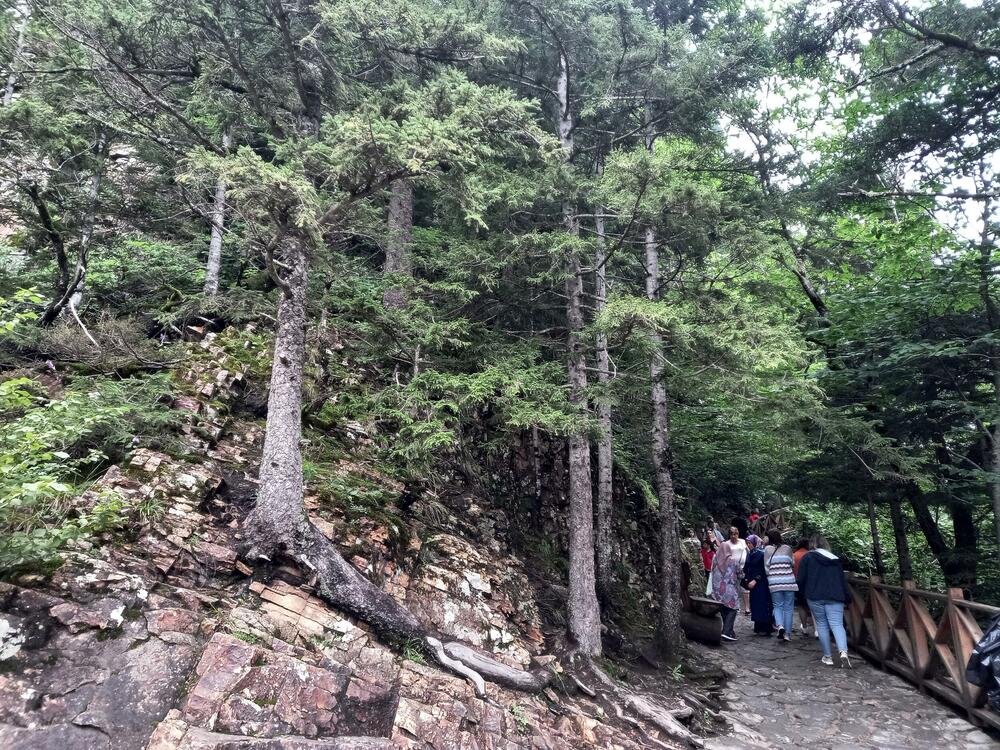
As you climb higher and higher, you will see more and more clearly the stone structure in the rocks, the distant and ancient monastery in the stone, and no matter how magnificent it looks from afar, you will only feel its power afterwards and be left speechless.
You leave cars and all forms of transportation behind and continue walking. Only then are you aware. Looking up, towards the object in the rocks in the endless sea of pine forest, you can only fantasize and imagine where and what you are going for, striving for heights. From afar, I see the iconic edifice beckoning and providing light through layers and layers of all shades and textures of the green forest. The contours of the ancient stone building are sharpened, which at the same time seems proud and fragile, rises, calms and heals, observing the endless hills, valleys, forests... Sumela monastery. And the forest is on all sides, the air is clean, fresh, fragrant, medicinal, to make you dizzy, and only the river, wild, winding, unstable, mountain beauty!
I climb and wonder where I'm walking, who has passed all those roads before, for what reasons and how long ago... I'm careful not to slip on the steep path, but I look everywhere except at the feet I'm treading on. I look around, smell and inhale, turn around. As I climb more and closer to the Sumela monastery, I feel something important and big, I wonder if I am really walking through these incredibly beautiful, historical, heavenly areas. I think and wonder if this is how pilgrims feel at least partially as they travel, search, flock to their holy places, to faith, to life, feeling closer to their religion... I also wonder if this is how tourists and believers who for the first time feel they visit the Ostrog monastery...
I keep walking through that national park, I jump over the steps and I don't know if the decades and centuries old trees, the roots that spread freely, tangle, intertwine, the freshness of the pine, the water whose strength moves you and which you feel under you, cause greater admiration its strength in itself, because water is everywhere. I try to breathe, to breathe fully, as deeply as possible*. I pause occasionally. And even though the line behind me and in front of me is constant, in both directions, in some even rhythm, and even though barely two people can walk along the path at the same time, and I pause, they don't protest, I don't bother them and I don't feel their nervousness and impatience , as it would perhaps be anywhere else. Instead, they quietly pass by, bypassing me, or they also stop to see if something slips by them. I notice myself doing this.
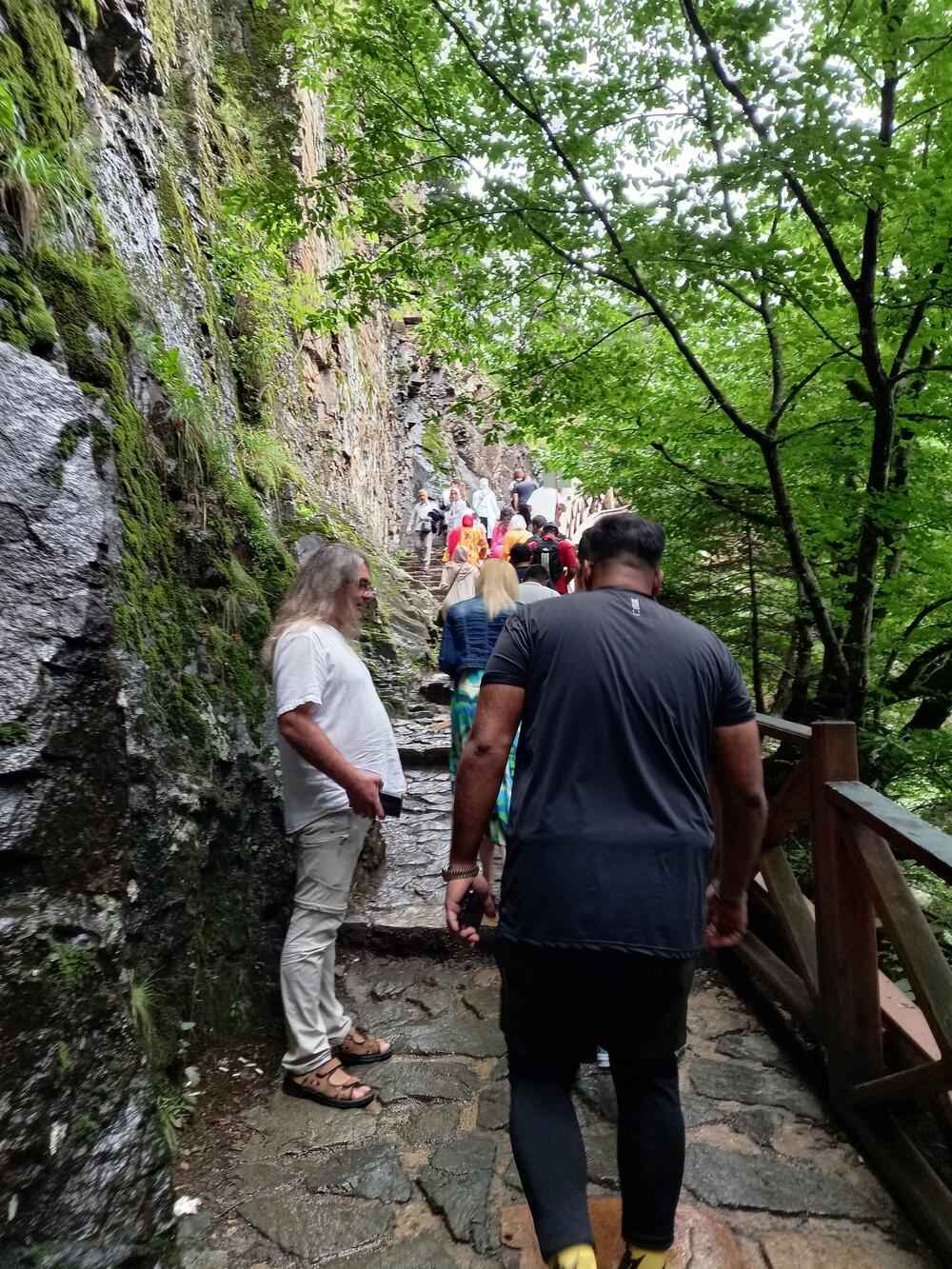
Whenever someone looks at something near or far away, my eyes also rush, they want to see, they want to absorb, they want to remember. I try to remember. I try to take some of that with me. That's why I breathe so deeply, and as I write, I have the feeling that a trace of that air is still in me. I love the fresh air, and I also love that it seems to be different everywhere. It seems to me that if I breathe that air that I want with enough dedication and absorb that view with my eyes, I carry those parts within me and with me.
I'm walking along a narrow path where barely two people can stand next to each other and it seems to me that hundreds of people are walking one after the other, passing each other, stopping, as if they don't touch the ground they're walking on...
I'm afraid I'll miss something, and my eyes and thoughts are scattered. I don't know and I don't want to decide whether I am more impressed by the long, thick and powerful roots of the trees on my left, the delicate and rugged upturned trees, crowns and leaves, or the needles that talk, testify, play with their hum, or is it the view from on the right side that stretches into the endless greenery of the national park, the river that you only see here and there and the springs that occasionally appear, but whose energy, purity and life-creating power you feel under your feet, in your lungs, eyes, mind... And maybe it is all this is exactly what I'm going to - the Sumela monastery, which, as I approach, I can only see, sense and perceive from a few bends, but which is the starting point of this tour.
A steep, narrow and long path uphill, a staircase on some sections, but also benches, trash cans, an extension on the side... And so the motifs change, but nature is constant, the forest and the air that I wrote about, but also the water that is all around you, either as puddles you step on, free as it flows, from a built fountain or next to it, down the rocks, but it fascinates that no one "tried" to stand in its way and oppose nature, let alone the fresh drinking water that is already, but will only be in the future, a source of wealth, luxury and health at the same time. And indeed, although I only tasted it at the end of my walk, the water in Altindere National Park in the vicinity of Sumela Monastery is unusually fresh, and while you drink it from your hand, you feel its energy, the matter from which everything came.
Kanje, I just found out that there is still a belief among the people about the existence of healing waters, just within the Sumela monastery complex.
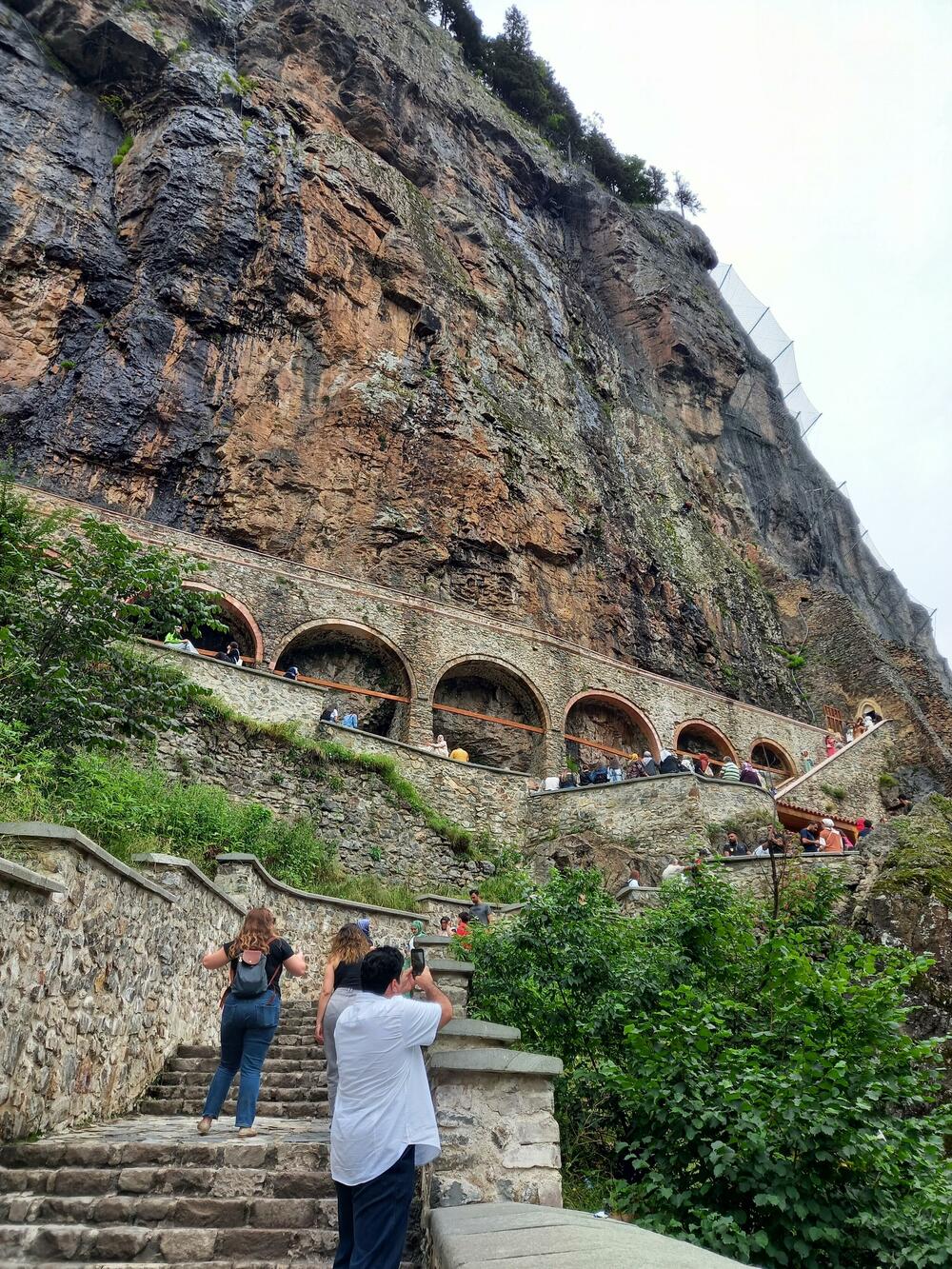
And before you reach the place where the space widens and the roads fork, you will hear music. I have the feeling that there is always a (street) player, a musician on that one, same part of the road, who provides a soundtrack with authentic Turkish melodies to everyone as they approach the entrance and area of the Sumela Monastery. You will hear it just as your narrow vision is replaced by time, wind and water carved rocks and a wall behind which hides the edifice, an ancient stone city on top of a mountain among pines.
And before you continue to Sumela Monastery, not far from the musicians whose music you can still hear and with whom you have merged, the road forks, so before the next steps you have the opportunity to rest while visiting the remains of the Aja Varvara church on the right. I walk around the remains, I step on the old stone that still makes the exterior shapes and I realize that there is something huge that attracts me to the stone, the rubble... Maybe the reason for this is my homeland Montenegro or my childhood and growing up that I associate with the (insufficiently) popular Bedem or liti "Onogošt" in the center of (my) town Nikšić, and I remember the Wall when it was not organized, arranged and accessible (if it is at all today) when as a child I climbed the stones to the very top, which seemed far away at the time, fantasizing about what is on the other side of the tower and how life was organized...
But Aya Varvara is there and definitely should not be missed and bypassed, whether you are exhausted from the long climb or not, but this historic church on the way to Sumela offers a breath of history and breathtaking scenery and prelude to what is to come.
Ancient city in the rocks
And after a few more stone steps, there is a place that carries the weight of Christian culture, the strength of the architecture of the past, the eternity of stone and faith in people. Next to the entrance door there are guardrooms, and again stairs lead to the inner courtyard. The space is big, unimaginably bigger than it seems to you when you look at the monastery from afar. The view is magnificent and incredible, worth every meter walked and/or money invested. You are opening the door to a hidden city, a haven, a place where civilization flows and life teems, tranquility, pleasure, and charm spread.
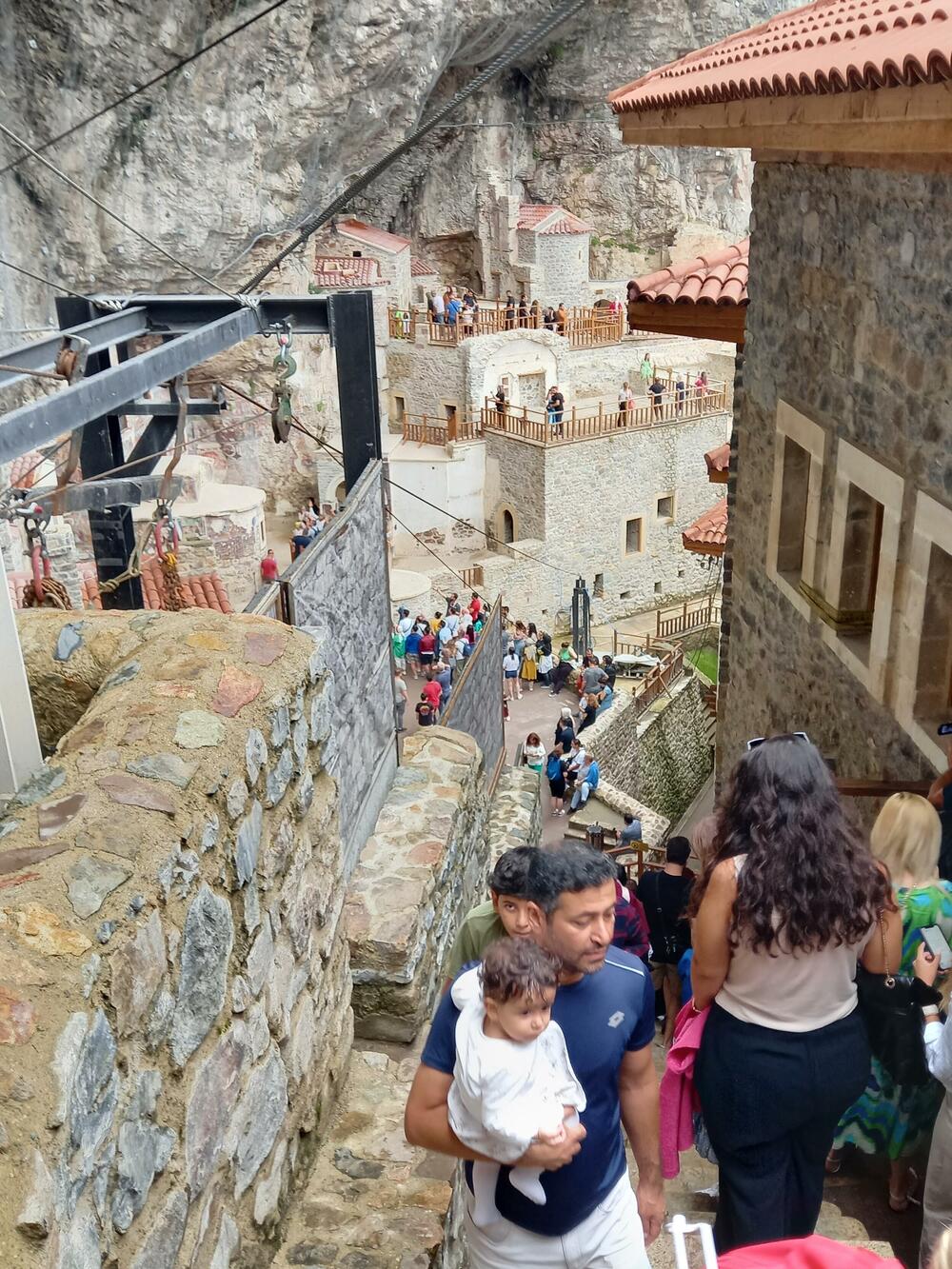
The Sumela monastery complex consists of several buildings of different purposes, and the center of the entire building is a cave church around which are placed several chapels, a kitchen, student rooms, rooms for tourists, a library, a bell tower, but also the holy spring of water Hagiasma, or spring of holy water. The buildings, towers, chapels, and churches listed in this way seem simply placed, but I got the impression that each of these rooms hides something of its own, purposefully placed and made, which the visitor can miss. Thus, if you peek into some of the tunnels in the corners that seem like ruins and neglected passages, you will be offered a view into the secrets and deep mysteries of the stone of the Pontic Mountains.
After the last steps, you go up, go down and enter everything that makes Sumela Monastery. On the left, in front of the cave, that is, the cave church, which is the foundation of everything that exists around today, there are various buildings that together represent a monastery with an inn, which was later turned into a church and a library on the right. They tell me that on the right is an area with a large balcony that was used as a monastic guesthouse, with guest rooms.
In the center of the complex is an open space surrounded by the listed objects, and above all that a rock rises as if embracing the monastery. I go straight to the cave church, the cave, the main chapel on the site of the former cave from which everything originated. Before entering, there are various frescoes with numerous motifs on the outer wall. Those frescoes that tell some of the recognizable biblical stories in the pictures stand out. Thus, frescoes exist not only in the interior of the monastery, but also the entire exterior wall of this church is completely painted. People are constantly coming in and out, but despite the crowds, the place is isolated and peaceful, enchanting with its appearance and monumentality.
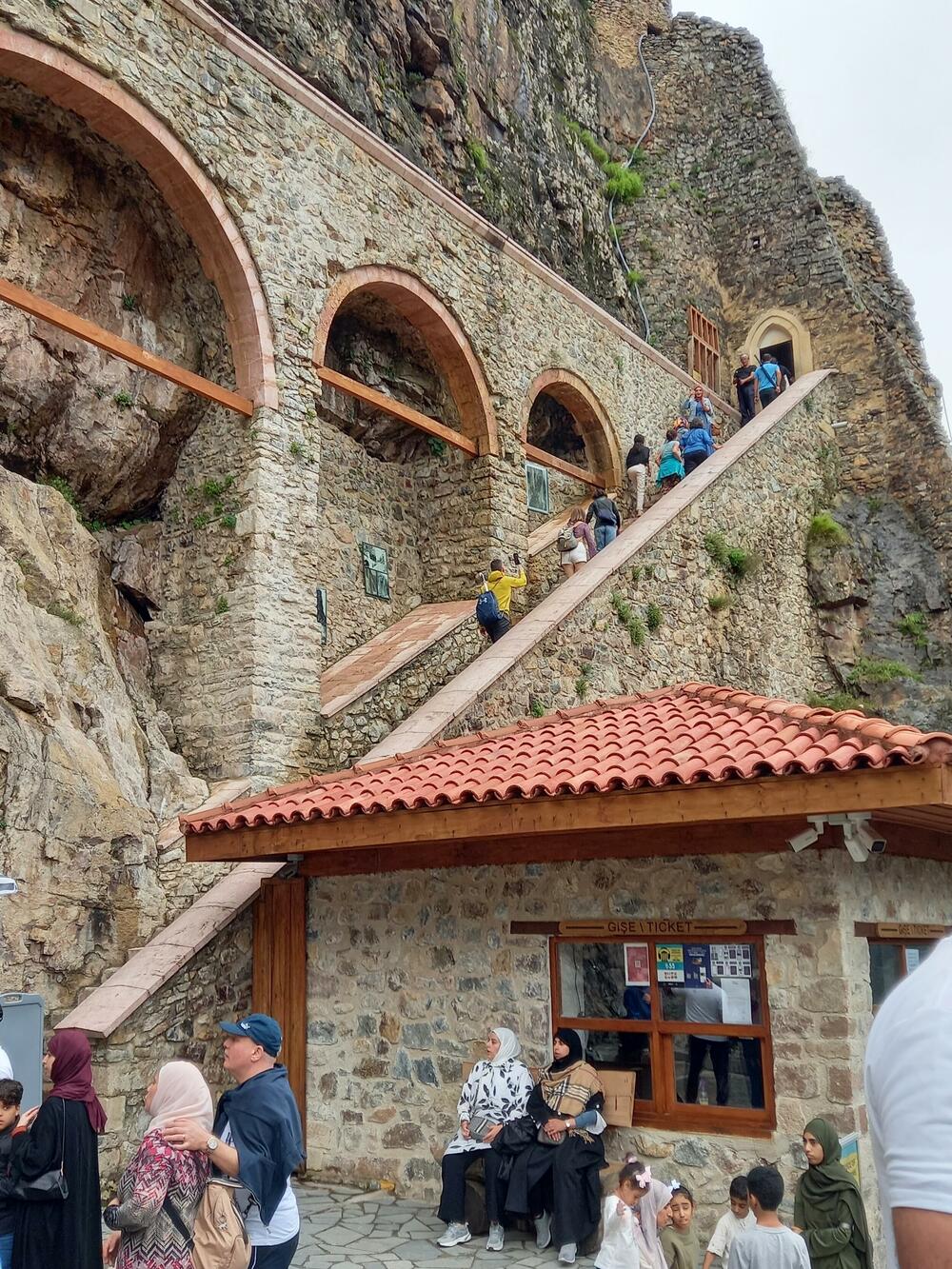
I enter the church whose interior is covered with unique artistic frescoes. Everything is painted in detail, the birth of Mary and her presentation in the temple, the preaching, the birth of Christ, her presentation and life in the temple, but also the death of Mary and the death of the apostles. In the upper part of the church, on the east side, the book of Genesis, the creation of Adam, the creation of Eve, the admonition of God, the rebellion of Adam and Eve who eat the forbidden fruit together, the expulsion from paradise and then the resurrection, the infidelity of the apostle Thomas, the angel in the tomb of Jesus, are shown. the rock outside the tomb, the angels Michael and Gabriel, there is also the baptism of Jesus in the Jordan River, frescoes with pictures of miracles that Jesus performed, from when he healed a blind child with the touch of his hand, to when he made a motionless man walk and many others, and on the frescoes are the apostles of Jesus, his mother, the Virgin Mary...
The walls tell a story, awaken imagination, respect, as I listen and turn around the room. And only looking up, towards the ceiling, then the sky, offers the special and probably the most significant frescoes of this building. The frescoes on the rounded ceiling provide depth of space, but also of time, and if you look up, you will see them all best by not looking away from them and by letting your body be carried away by trying to see them while spinning around your axis and adjusting the position of the frescoes on the ceiling...
The central fresco on the ceiling of the stone church is of Jesus, and right next to it is an exceptional and especially valuable fresco of Mary, the Mother of God, with the baby Jesus. They both have halos above their heads as a symbol of Christianity, and Mary is holding the baby Jesus on her stomach, whose hands are in a blessing position. On the next icon, the Virgin Mary holds the "Almighty Mother" in her lap of the baby Jesus, which is one of the rare depictions, and in addition to their two figures, there are also two winged beings closest to God who carry a throne on which God is believed to be seated, Cherubim and Seraphim.
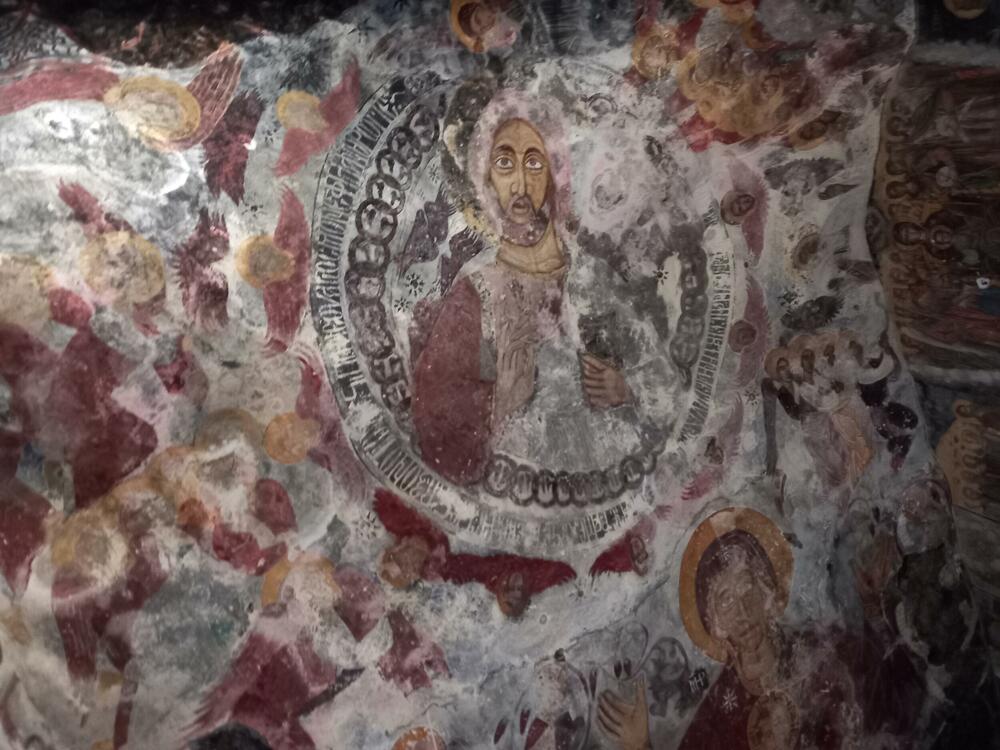
Those icons on which Mary is with Jesus have a special value. The frescoes date from the 18th century and were painted at different levels and in different time periods. Although the frescoes at the bottom work better, those on the ceiling are still fascinating, and a special impression is provided by the light that refracts through the small windows at the top of the church.
I turn around the room, aware of various paths and tunnels at the foot of the almost sloping walls. I look inside, the unknown... I go outside and go to the room across the street from which there is a view on both sides of Sumela. Characteristic Turkish art is also present in courtyard buildings, rooms, windows, sheds, and doors. I climb up and enter the space that offers a kind of exhibition of the Sumela Monastery through time, as well as recent renovations. Old floor, clean windows overlooking the main area around the cave church and windows on the other side with a view of the sea of the forest of the national park. There is a window on the third wall, and only then do I realize where this place is and think about how it was built and how it survived. The cliff and chasm is below, the rock like guardian above, and the infinity of pines all around.
There are similar scenes in other buildings, and definitely the cave church with all the frescoes impresses the most. Unfortunately, it can be seen that the Sumela monastery also went through periods of vandalism that left traces and changed the original depictions. Also, manuscripts, books and documents found in the monastery and its surroundings are kept in museums in Ankara and Istanbul.
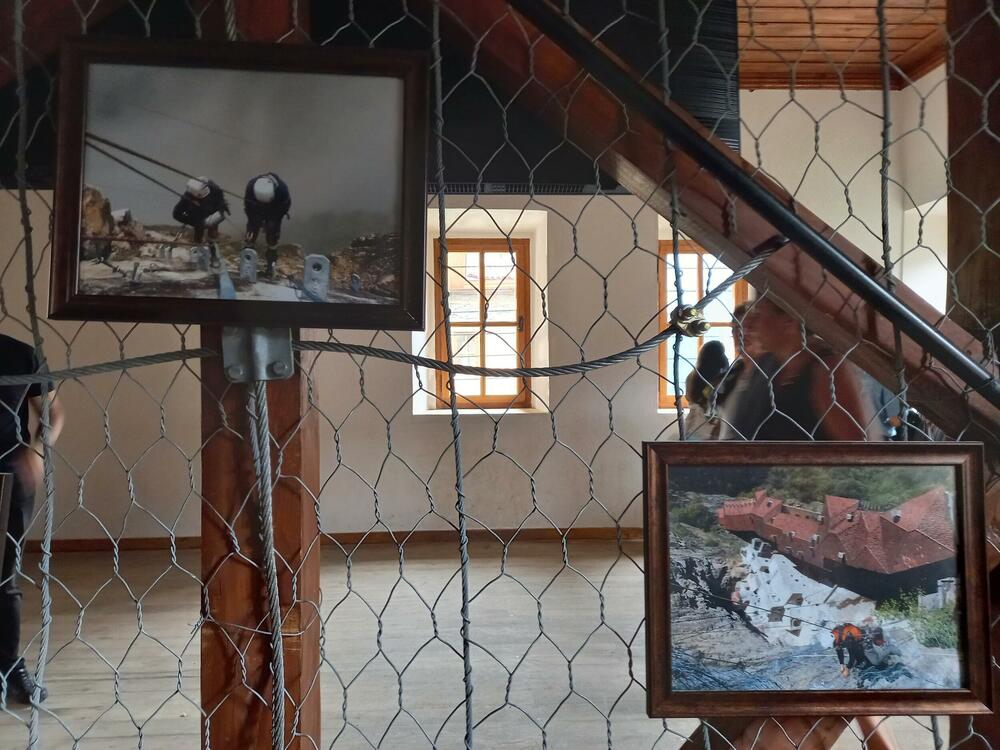
I go out, I take photos, I want to remember the place where I stood and which seems special, in the world, I would say. I also find out that there is a fountain with mountain water nearby, but also a source of holy water, which is believed to provide people with cold water, hope for healing, and healing even today, centuries later. Thus, in the center of the Sumela monastery, which I have already called an ancient city, there is actually a sacred pool into which large drops of water fall at irregular time intervals, bathe and offer hope for healing and medicine. As everywhere, he wanders there for a few coins. The guide tells us that once upon a time, people of all faiths came together to the Sumela monastery, from all over the world, just for that holy and healing water and that they brought with them gifts and wealth that they would leave to the monastery.
I don't know if it's because of the holy water, the unique icon and the cave church, because of anthropological and archaeological curiosity, but even that day I noticed that tourists come from all over the world, greeting each other with a smile or a smile in their eyes, and even with words...
The Sumela monastery is one of the particularly attractive locations and routes for tourists for a reason, and in addition to the monastery being a witness of layered culture, religion, past and history, the place where it is located, surrounded by mountains, springs, endless nature, as part of a national park Altindere, makes it attractive geographically, but also historically, culturally, scientifically, and touristically popular.
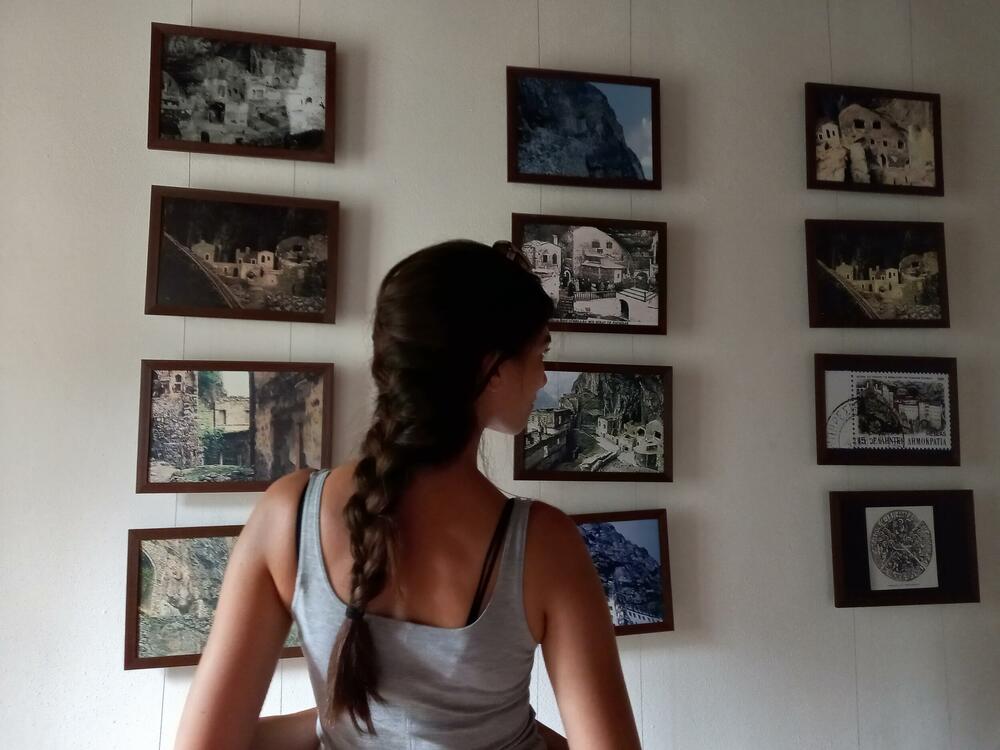
I'm here a little longer and soon we're heading to another destination. We comment, we convey impressions, and we are silent, and that is how we say the most. I get lost somewhere again, I walk around, pay attention and think if I have missed something, because there are so many contents and objects that I am afraid that I must have omitted or skipped over something important. And yet, I saw a lot. Yes, I am aware that due to my curiosity and intoxication with the building, the atmosphere, the space and the time that passes in the Sumela monastery, I did not have time to sit down in a restaurant not far from the entrance, drink Turkish tea or coffee, but now it does not seem so important to me, except which meant that I left out the purchase of souvenirs that I like to collect. But instead of a magnet or some kind of decoration, I have a living experience that has enriched me, a memory that awakens, enlightens and stimulates energy that smolders, as well as air and water that I have tasted and that I keep.
Sumela Monastery, a powerful edifice that inspires respect and admiration.
The Karaca Cave is an unmissable stop
After Sumela, the usual tour is to the Karaca Cave. It's fascinating that you really don't know which view is better, but on the other hand, the question is whether you can endure all this beauty in the same day, and the impressions of both places remain alive, strong and credible.
Legend has it that the cave was found by a hunter while he was chasing a rabbit that was hiding in a hole, and then, looking for it, the hunter saw a deer and started following it. The deer led him to the cave, which the hunter later named with a name that, in some translations, also means Deer's Cave.
It is another natural phenomenon that enchants tourists with its colors and jewelry - stalactites and stalagmites, for which it has been open since 1996, after the Ministry of Culture and Tourism officially registered the cave, although the locals knew about it before.
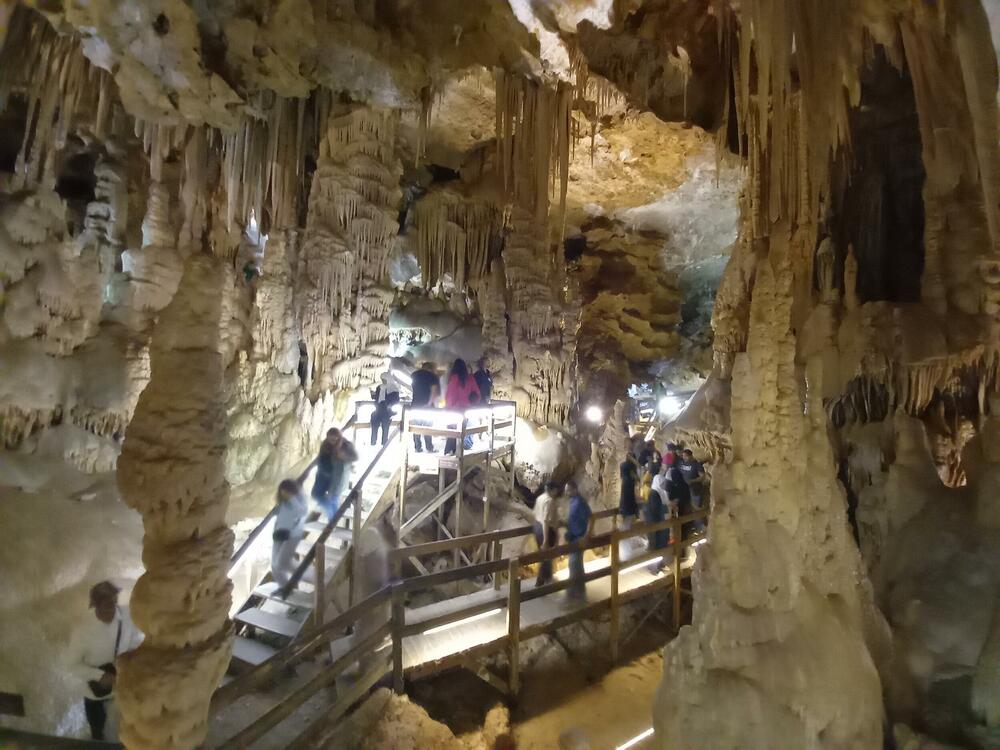
The Karača Cave amazes at the very entrance, which is about 180 centimeters high, but the ceiling slowly expands and offers a fascinating view from a frog's perspective. The cave is characterized by rich rock formations of various shapes and colors, as well as many cave roses. Every part of the cave is moist, with a special smell, like semi-precious stones, and the presence of a high level of iron and magnesium minerals is also evident. In addition, due to the significantly high level of oxygen, the air of the Karachi cave is said to be a good remedy for many respiratory diseases.
It is interesting that the air in the cave is cooler in summer than outside, and on the contrary - warmer in winter, so it is believed to have its own microclimate.
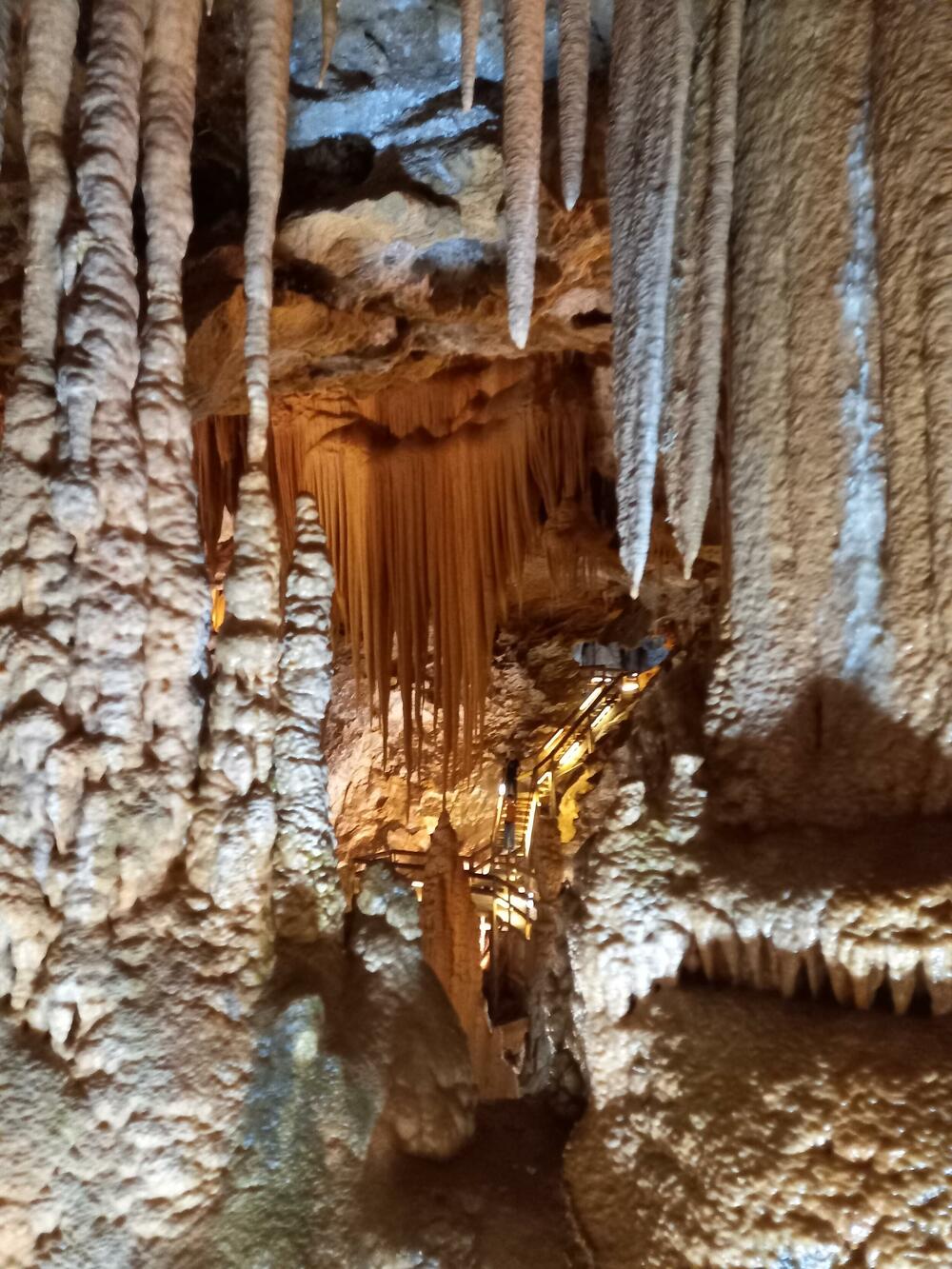
Only about a hundred meters long, with an average height of 18 meters, with a total floor area of 1.500 square meters, the Karača Cave is an obligatory stop on the way to or from Sumela Monastery. Despite being small, Karacha Cave impresses.
Travel as the key to self-discovery and wealth
Upon my return, and during the writing of this text, I am thinking about Montenegro, which abounds in various riches, from the natural beauty of lofty and impregnable mountains, impassable canyons, turbulent but also calm rivers and the beautiful sea, and there are also small towns, specific styles of architecture, old cities, ramparts, museums, castles, cultural centers, monuments... I think and wonder why we are not aware of what we have...
I am afraid that we will remember our jewels again only when they are destroyed or when they become the subject of division, and I want to be wrong in this case, because I guess years and years of empty and unnecessary fights have taught us wisdom. Nature does not know about it. And if we listened to her a little more and adapted to her, maybe we would clear our lungs of the poisoned smog of other people's words and manipulations. Maybe by traveling and getting to know each other.
Perhaps, just like believers of all religions, curious atheists and agnostics, historians, archaeologists, anthropologists, travelers eager for an unforgettable tourist experience, travelers eager to get lost in a foreign land, desert and language, we would become better people, better neighbors by taking joint steps towards self-fulfillment. , better friends, co-workers, parents, children, better not only towards each other, but also better towards ourselves, towards society, the country, the nature we inherited...
I have a feeling that it is up to us to learn and realize how to live in harmony with ourselves, nature and everyone else.
Traveling and getting to know other countries, foods, cultures, mentality, traditions, languages, facial features, may be one of the keys to all of that.
Bonus video:



